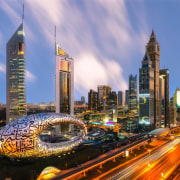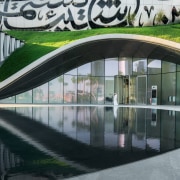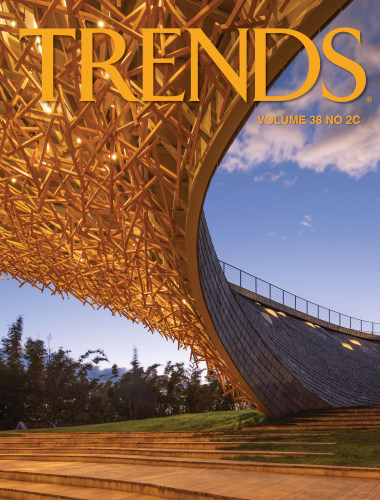Portal to the future
Want to look into the future of our planet? The Museum of the Future presents just such an opportunity in a structure that was itself a journey into the unknown for architects Killa Design
Designed by Killa Design
Even in a city such as Dubai where buildings rise from the ground up with extraordinary speed and precision, the Museum of the Future stands out.
Situated alongside the main arterial highway beside the driverless metro system, it is an expressive and dynamic landmark collaboratively built by human and machine.
The glimmering, futuristic building represents humankind in all its strength, creativity and unmatched ability to exist within its surroundings.
The elliptical void represents the unknown; a statement of all that which we do not yet know – in a word, the future.
Its Arabic calligraphy-wrapped façade displays Emirati passion for the arts, culture, discovery and the endless pursuit of knowledge, innovation and progress.
It includes a quote from His Highness Sheikh Mohammed bin Rashid Al Maktoum, the Ruler of Dubai: “The future belongs to those who can imagine it, design it and execute it. It isn't something you await, but rather create.”
Windows allowing natural light to flood into the seven-storey structure are designed in the form of the calligraphy intricately 3D-mapped onto the building’s curved body.
Quite a sight
Standing 77m tall, the avant-garde façade is made of stainless steel and glass, consisting of 1024 separate panels, each one specially created by robots and algorithms.
The number of panels has its own significance – it represents a basic unit of the digital information storage system of computers, which is a kilobyte, and each kilobyte is equal to 1,024 bytes.
The Arabic script windows cast light into the interior by day and at night illuminate the city’s iconic skyline with 14 kilometres of energy-saving, resource-efficient LED lights.
Due to the building’s complex geometry and flowing calligraphy, each separate panel is unique.
Each piece had to be individually precast and produced, with numerous prototypes designed and manufactured before a winning formula could be achieved.
Amazingly, every single panel was produced using automated robotic arms, is made up of four layers and is created following a complex 16-step process.
A lot to consider
Parametric modelling was essential to determine the final position, size and dimensions of the Arabic lettering on each panel to ensure it offered optimum balance between natural light, solar heat gain and air conditioning load without compromising its architectural aesthetic.
The low-carbon project features passive solar architecture through its extraordinary façade, as well as low-energy and low-water engineering solutions with integrated renewable capabilities.
Translating the artistic and symbolic concepts inherent in the design into a 30,000m² (approx.) building clad in stainless steel was always going to be a challenge.
Add to that the building’s unique torus shape, the owner’s (the Dubai Future Foundation) requirement to attain LEED Platinum status, and the team’s determination to embrace BIM at every stage of design and construction, then clearly, the building’s centre void was not the only aspect of this project that represents a step into the unknown.
The bigger picture
Specialist engineers developed bespoke in-house optimisation routines to model and analyse numerous options for the structure to achieve the Museum of the Future’s iconic shape.
The outcome was a solution comprised of a complex diagrid framework directly aligned to torus shape and capable of supporting the 890 stainless steel and glass fibre reinforced polymer (GFRP) panels that form the intricate silvery facade.
Working in a BIM environment also proved invaluable in working towards achieving the LEED Platinum accreditation stipulated by the owner.
The architects created a 3D energy model in which all 12 disciplines could interact in real time, agreeing more than 50 sustainable design decisions that resulted in a range of tangible benefits including a 45% reduction in water use and total energy savings of 25%.
The installation period for the façade lasted around 18 months.
Essentially, the structure is an architectural marvel, built by using robotic technology and with an emphasis on sustainability – the building is powered with 4,000 megawatts of solar energy. The pillarless building accommodates seven unique and distinct floors.
Window to the future
For its visitors, The Museum of the Future comprises an unparalleled window to experience the future in all its aspects and dimensions.
The museum employs the latest technologies of virtual and augmented reality, data analysis, artificial intelligence and human machine interaction.
Answering many questions related to the future of humans, cities, societies, life on planet Earth and outer space, the museum’s exhibits orchestrate a world beyond human knowledge, providing visitors with innovative experiences unfolding across five different exhibitions that explore the future of space travel and living, climate change and ecology, health, wellness, and spirituality.
Coming face-to-face with never-seen-before space technology and getting introduced to humanity's home in outer space, the visitor’s journey begins in the depths of our solar system, while also paying tribute to the inspiring Emirates Mars Mission project that saw the Hope Probe successfully enter Mars’ orbit last year.
The future in its making
The Museum of the Future experience encourages its visitors to partake in special missions and, unlike a traditional museum that showcases fragments of the past, it provides a portal to the future, in a scientific attempt to explore its variables, potential challenges and expected characteristics.
The immersive experience will also see its visitors in an entirely new environment as they are re-introduced to planet Earth, the future of healing, sustainability and bioengineering technology.
Reflecting the UAE’s ongoing work in sustainability and environmental stability, this part of the visitors’ journey also highlights the UAE position as one of the first countries to announce its commitment to achieving climate neutrality by 2050, and offers a homage to the country’s efforts in planning to host the 28th United Nations Framework Convention on Climate Change (COP 28) in Abu Dhabi in 2023.
In an environment centred around health, wellbeing and the sense of self, visitors embark on a peaceful and empowering journey, as light is shed on reconnecting to human senses and learning to detach from the personal immense use of technology.
The Museum of the Future also showcases novel innovations from the near future through its partnerships with industry-leading companies and organisations to highlight emerging technologies and trends created for the betterment of humanity.
Fostering young minds
Believing that the future does not have an age preference, this museum will provide children with a dedicated experience that encourages their young minds to explore and learn several future-proofing skills through an open-world experience, in an approach that helps them to innovate and create the future they look forward to and to become a pivotal part of its characteristics.
Key takeaways
- The museum is described as “the most beautiful building on Earth”. Reaching 77 metres in height, with seven floors inside and no internal pillars. The museum is an engineering miracle.
- The museum is a model of sustainability. The entire surface of the building is made of developed glass, manufactured with new technologies to improve the quality of the interior and exterior thermal isolation.
- The facade of the building extends over an area of 17,600 square metres. Made of stainless steel, the facade panels were produced using automated robotic arms.
- The museum’s design pays homage to digital technology, through the 1024 panels covering its facade. The specific number of panels represents a kilobyte: a basic unit of the digital information storage system of computers. Each kilobyte is equal to 1024 bytes, or 1024 symbols or characters.
- The facade of the museum is lighted by 14 thousand metres of programmable LED lighting. Made up of quotes written by HH Sheikh Mohammed bin Rashid Al Maktoum, the Museum of the Future is the only building in the world that is entirely covered with Arabic calligraphy.
Credit list
Engineering services
Architect
Designed by: Killa Design
Story by: Trendsideas
Home kitchen bathroom commercial design
From farmhouse to farmstead
Walk this way – garden pathways to lead your thinking
Bigger or smaller?



















